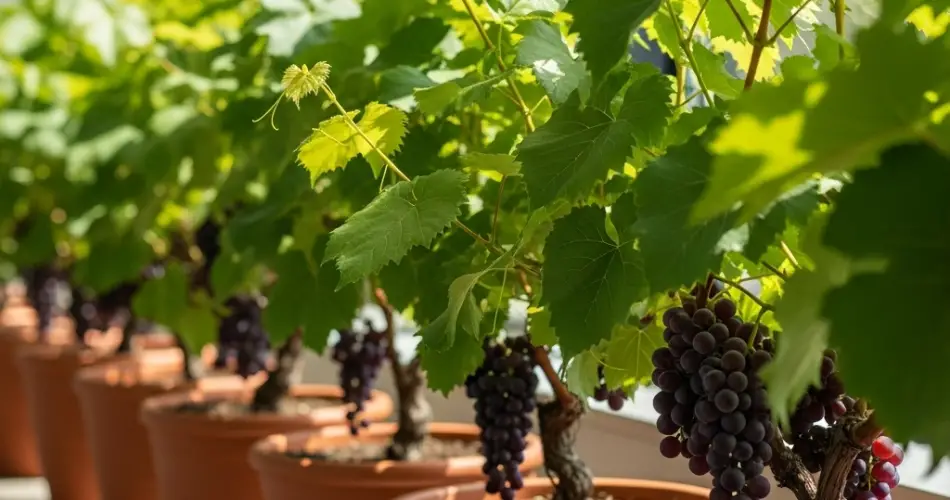Grapes are a timeless fruit, celebrated for their sweet flavor, ornamental appeal, and versatility. While traditionally grown in sprawling vineyards, grapes can also thrive in containers, making them accessible to home gardeners with limited space. Whether you’re working with a small balcony, terrace, or patio, growing grapes in pots is not only possible—it’s rewarding.
This beginner-friendly guide covers everything you need to know to cultivate healthy grapevines in containers and enjoy your very own homegrown harvest.
Why Grow Grapes in Pots?
Container gardening offers a number of advantages when it comes to grapes:
-
Space-saving: Ideal for small gardens, patios, or balconies.
-
Mobility: Move the pot to catch sunlight or protect it from harsh weather.
-
Soil control: Reduce the risk of disease and pests by using fresh, well-draining soil.
-
Aesthetic appeal: Grapevines provide lush foliage and beautiful climbing vines, making them both decorative and functional.
With the right care and setup, you can expect your potted grapevine to yield fruit within a few years.
Choosing the Right Grape Variety
Success begins with the right grape variety. Not all grapes are well-suited for container growth, so it’s best to choose compact or disease-resistant varieties.
Good choices for pots include:
-
‘Lakemont’: A seedless white grape with good disease resistance.
-
‘Reliance’: A cold-hardy, red seedless variety.
-
‘Canadice’: Early ripening and compact growth.
-
‘Thompson Seedless’: Classic table grape, thrives in warm climates.
Look for varieties described as self-pollinating if you plan to grow just one plant.
Selecting a Container
Grapes develop deep root systems, so choose a container that is large enough to accommodate long-term growth.
Container requirements:
-
At least 18–24 inches deep and wide
-
Made from durable materials like plastic, wood, or ceramic
-
Equipped with drainage holes to prevent waterlogging
A half wine barrel or a large planter works well. Place it on a stand or wheeled tray to make repositioning easier.
Preparing the Soil
Grapevines prefer well-draining, loamy soil with a slightly acidic to neutral pH (around 6.0 to 7.0).
Soil mix suggestion:
-
1 part high-quality potting mix
-
1 part compost or aged manure
-
1 part coarse sand or perlite for improved drainage
Avoid using heavy garden soil, which can compact and restrict root growth in containers.
Planting Your Grapevine
Once you have your pot and soil ready, it’s time to plant.
Steps:
-
Place gravel or broken pottery at the bottom for drainage.
-
Fill the container halfway with your soil mix.
-
Position the grapevine in the center. Ensure the crown (where the stem meets the root) is just above soil level.
-
Backfill with soil, press gently, and water thoroughly.
Add a layer of mulch on top to conserve moisture and suppress weeds—but keep it a few inches away from the base of the stem.
Providing Support
Grapevines are natural climbers and need sturdy support to grow well.
Support options:
-
Trellis
-
Arbor
-
Stake-and-wire system
Secure the main stem to the support as it grows. Regularly train side shoots and trim excess foliage to maintain airflow and direct energy to fruit development.
Light, Water, and Feeding
Grapes are sun-loving plants. Ensure they receive at least 6 to 8 hours of direct sunlight each day.
Watering tips:
-
Keep the soil consistently moist, especially during hot weather.
-
Allow the top inch of soil to dry between waterings to prevent root rot.
-
Reduce watering in late fall and winter when the vine is dormant.
Fertilizing tips:
-
Feed with a balanced fertilizer in early spring as growth resumes.
-
Switch to a low-nitrogen fertilizer during flowering to encourage fruiting.
-
Avoid overfeeding, which can promote excessive leafy growth instead of grapes.
Pruning and Maintenance
Pruning is essential for container-grown grapes. It improves air circulation, supports fruit development, and keeps the plant manageable.
Prune in late winter while the vine is dormant:
-
Remove weak, dead, or crowded branches.
-
Leave behind strong canes (1-year-old wood) with healthy buds.
-
Train one or two main stems and prune lateral growth regularly throughout the growing season.
Well-pruned vines produce higher yields and are easier to care for.
Overwintering Your Potted Grapevine
In colder climates, containers offer the benefit of mobility. When winter arrives:
-
Move the pot to a sheltered area like a garage or unheated shed.
-
Mulch the soil surface to protect roots from freezing.
-
Water sparingly during dormancy, just enough to keep roots from drying out.
If your area experiences mild winters, leaving the pot outdoors with adequate mulch may suffice.
Harvesting Grapes
Grapes usually mature in late summer to early fall, depending on the variety. Ripe grapes:
-
Have full color
-
Are soft and sweet to taste
-
Pull easily from the stem
Taste a few before harvesting—grapes don’t continue ripening after being picked.
Final Thoughts
Growing grapes in pots is a satisfying and practical way to enjoy fresh fruit from even the smallest of spaces. With proper variety selection, good soil, adequate sunlight, and regular maintenance, your grapevine can flourish and produce bunches of delicious, homegrown grapes year after year.
Whether you’re dreaming of fresh table grapes or a small backyard harvest, container-grown vines offer a sweet and rewarding gardening experience.



